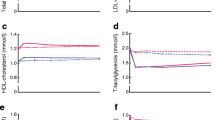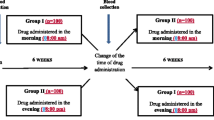Summary
Women with primary hypercholesterolemia are often considered for lipid-lowering drug therapy at a later age than men. With regard to the prevention of cardiovascular morbidity, women can expect to receive the same benefits from lipid-lowering treatment as men. Thus, it is of interest to evaluate the efficacy, safety and tolerability of the new lipid-lowering agent fluvastatin in women.
A retrospective analysis was made on the basis of data from controlled clinical trials in which 1815 patients were treated with fluvastatin at a daily dose of ⩾ 20mg, and 783 patients received placebo. 782 of the fluvastatin-treated patients (43.1%) and 315 patients on placebo (40.2%) were women. Within these groups, 577 patients (73.8%) treated with fluvastatin and 183 patients receiving placebo (78.4%) were at least 50 years of age.
The effect of fluvastatin 40 mg/day on low density lipoprotein (LDL) and high density lipoprotein (HDL) cholesterol was more favourable in women than in men. In women, the change from baseline was −26.7% for LDL cholesterol and 5.3% for HDL cholesterol. In men, the equivalent changes from baseline were −23.8% and 4.0%, respectively. All changes from baseline were highly significant (p < 0.001). Fluvastatin lowered triglycerides to a similar extent in women and men (7.1% vs 6.9%, respectively).
More women than men experienced a confirmed increase in aspartate aminotransferase (AST) and alanine aminotransferase (ALT) when receiving fluvastatin. Such increases were observed for AST in 3 women (0.4%) but no men, and for ALT in 10 women (1.3%) and 2 men (0.2%). In placebo-treated patients, no such increases in AST were observed (irrespective of gender) but increases in ALT were noted in one male patient (0.2%) and one female patient (0.3%). No notable increases in creatine Phosphokinase of > 10 times the upper limit of normal were observed in women. The tolerability of fluvastatin, as assessed by an analysis of adverse events, was not consistently influenced by gender.
In conclusion, an exploratory analysis of the efficacy and safety of fluvastatin suggests that it is effective, safe and well tolerated, irrespective of gender. The observed tendency to enhanced efficacy in women should be further evaluated by use of data from prospective studies in female patients.
Similar content being viewed by others
References
Bradford RH, Downton M, Chremos AN, Langendörfer A, Stinnett S, et al. Efficacy and tolerability of lovastatin in 3390 women with moderate hypercholesterolemia. Annals of Internal Medicine 118: 850–855, 1993
Bush TL, Fried LP, Barrett-Conner E. Cholesterol, lipoproteins and coronary heart disease in women. Clinical Chemistry 34: 60–70, 1988
Expert Panel. Summary of the second report of the National Cholesterol Program (NCEP) Expert Panel on detection, evaluation, and treatment of high blood cholesterol in adults (Adult Treatment Panel II). Journal of the American Medical Association 269: 3015–3023, 1993
Goldberg A. Prevention and treatment of coronary artery disease in women, the elderly, and children. A review. Coronary Artery Disease 4: 577–579, 1993
Gotto AM, LaRosa JC, Hunninghake D, Grundy SM, Wilson PW, et al. The cholesterol facts: a summary of the evidence relating dietary fats, serum cholesterol and coronary heart disease. Circulation 81: 1721–1732, 1990
Grundy SM. Cholesterol and coronary heart disease: future directions. Journal of the American Medical Association 264: 3053–3059, 1990
Heyden S, Heiss G, Hames CG, Bartel AG. Fasting triglycerides as predictors of CHD mortality in Evans County, Georgia. Journal of Chronic Disease 33: 275–282, 1980
Kannel WB. Metabolic risk factors for coronary heart disease in women: perspective from the Framingham study. American Heart Journal 114: 413–419, 1987
Leitersdorf E, Eisenberg S, Eliav O, Friedlander Y, Berkman N, et al. Efficacy and safety of high dose fluvastatin in patients with familial hypercholesterolaemia. European Journal of Clinical Pharmacology, in press, 1994
Moreno GT, Manson J. Cholesterol and coronary heart disease in women: an overview of primary and secondary prevention. Coronary Artery Disease 4: 580–587, 1993
Peters TK, Mehra M, Muratti EN. Efficacy and safety of fluvastatin in hypertensive patients: an analysis of a clinical trial database. American Journal of Hypertension 6 (Suppl.): 340–345, 1993
Sempos CT, Cleeman JI, Carroll MD, Johnson CL, Bachorik PS, et al. Prevalence of high blood cholesterol among US adults. Journal of the American Medical Association 269: 3009–3014, 1993
Shetty HGM, Routledge PA. Adverse effects of hypolipidaemic drugs. Adverse Drug Reaction Bulletin 142: 532–535, 1990
Steiner A, Weisser B, Vetter W. A comparative review of the adverse effects of treatments for hyperlipidaemia. Drug Safety 6: 118–130, 1991
Author information
Authors and Affiliations
Rights and permissions
About this article
Cite this article
Peters, T.K., Muratti, E.N. & Mehra, M. Efficacy and Safety of Fluvastatin in Women with Primary Hypercholesterolemia. Drugs 47 (Suppl 2), 64–72 (1994). https://doi.org/10.2165/00003495-199400472-00012
Published:
Issue Date:
DOI: https://doi.org/10.2165/00003495-199400472-00012




